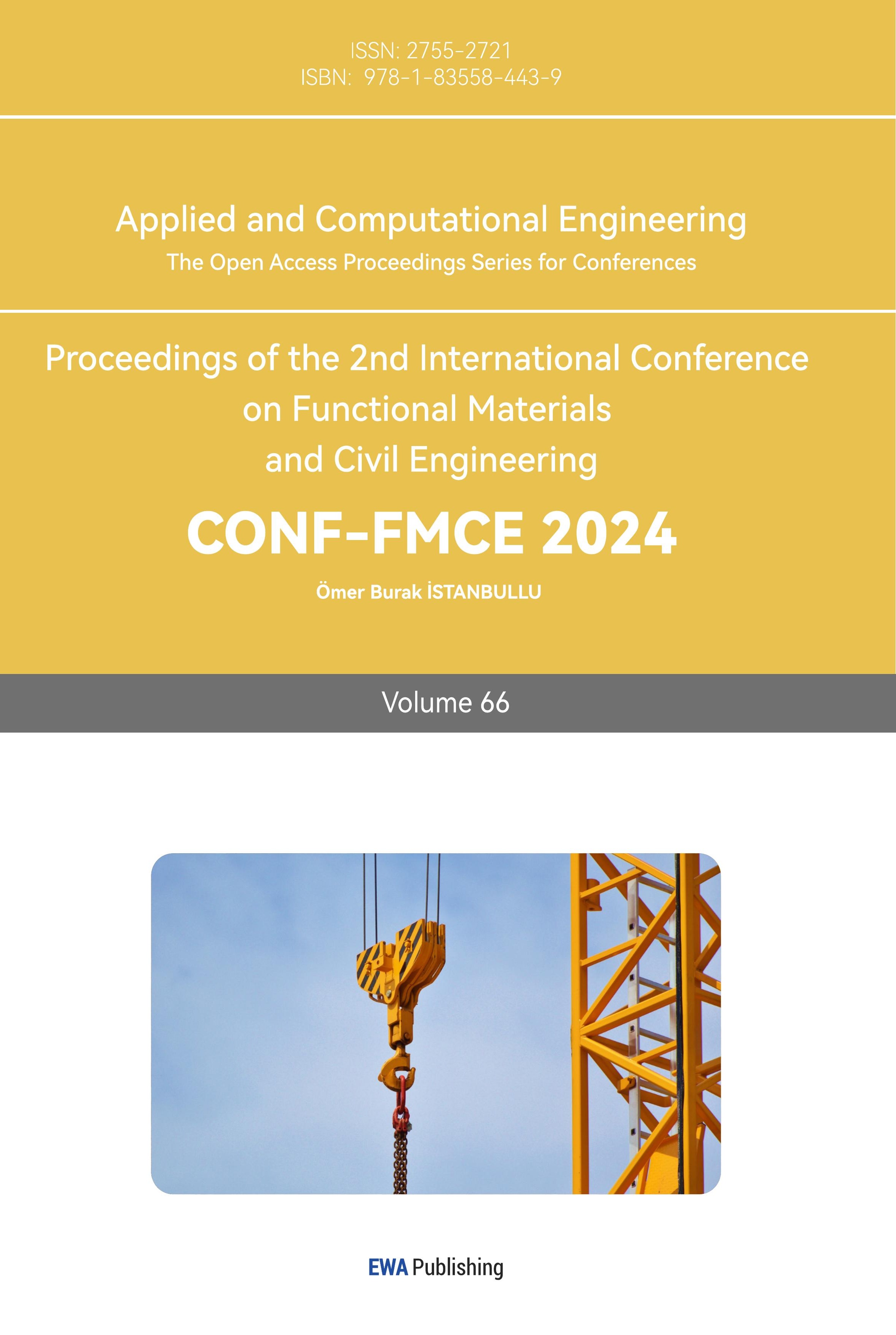1. Introduction
Automobile sports have always been a focal point in the world of automated sports, with automakers and teams doing a lot of experiments and developments into car designs that maintain stability at high speeds. There have been millions of researches about the aerodynamics analysis of race cars and how to keep stability at high speed. For instance, Porsche company has uploaded its own racing cars’ history and research on different periods on the Internet, which can be found on Google. Meanwhile, aerodynamics plays an important role in the performance and safety of these vehicles [1], and its design is applied to the shape and various components of the car to ensure that the vehicle can maintain stability at high speeds. With record vehicles, low drag and straight-line stability have top priority whereas racing cars have additional requirements, such as outstanding road holding and high cornering capability. Sports cars often combine all of these factors with everyday utility. Even though many experiments have been done before, this paper will mainly focus on the summary of key factors that affect the stability of race cars at high speed. Through the detailed scientific analysis of all the above key factors, we can better understand the importance of aerodynamics in car design and provide useful inspiration for future car design. For example, the future race car design may get a larger chassis to lower the centre of gravity of the vehicle, reducing the risk of rolling, which is more suitable for high-speed driving. Additionally, a more streamlined car shape can easily decline the air drag forces. These inspirations are exceedingly helpful for future race cars that use oil as a fuel or not, such as electrical race cars and hydrogen internal combustion engine vehicles [2].
2. Vehicle Streamline Body
Whatever object is moving in the air in the atmosphere, four forces are acting on this object in a three-dimensional space, The first one is the gravitational force, which points vertically downward to the centre of the Earth in the Y-direction. While moving in the air, drag force, interfering with its motion, acts in the X-direction and lift force, acts in the Y-direction and points straightly upward, which is in the opposite direction against the gravitational force. In addition, side force, in the Z-direction, is quite important in cases of strong cross winds and when passing. However, our main topic is related to race cars, and racing people tend to believe that their vehicles are so fast that side wind effects are negligible [3]. Therefore, the shape of the race car has become one of the key factors of stability because it can balance the magnitude of three forces at the same time.
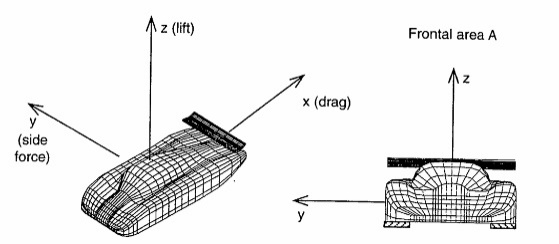
Figure 1. Coordinate system used to define the directions of aerodynamic loads on a vehicle, and the frontal area used to define the force coefficients [3].
The shape of cars changed in an evolutionary rather than a revolutionary manner over the years, and at first for reasons other than aerodynamic ones. Taste, perhaps influenced by the fascinating shapes of aircraft, called for smooth bodies with integrated headlamps and fcndcrs (the “pontoon body”), and production technology made them possible. Better flow over the car and thus lower drag was only a spinoff. But, finally, the two oil crises of the 1970s generated great pressure to improve fuel economy drastically and provided a breakthrough for vehicle aerodynamics. Since then, drag coefficients have come down dramatically. This has been a major contributor to the large improvements in fuel economy that have been realized.[4] Compare the shape of plane wings and car bodies, wings usually generate lift they also create drag. It is usually much smaller than the lift, and it can be reduced by streamlining the shape (having a smooth external surface). The reason why the wings on the plane should be installed and acted inversely on the race car is because planes require lift force to fly but race cars need to make sure that they are stable while driving on the ground at a high speed. Thus, the shape of the car should have forces in the opposite direction, resulting in downward pressure.
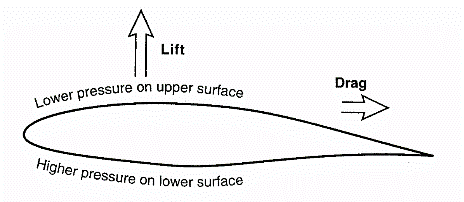
Figure 2. The low pressure on the upper side and the higher pressure on the lower side of this airfoil add up to the lift force [3].
When an object is moving in the air, the flow of fluid will separate into two parts. Some of it goes up, some of it goes down. The “upper” parts can affect the boundary of the roof and the “downer” part will affect the shape of the chassis, which links to the Ground Effect of the race car. When the “upper” part flows, the graph Fig.3 portrays the path of the air passing through the roof and the chassis of the car.
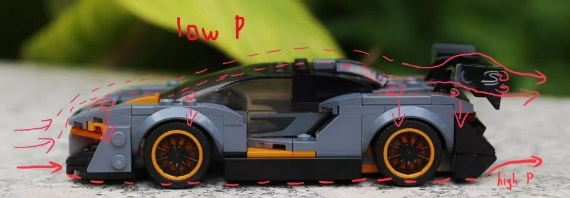
Figure 3. The path of the air passing through the roof and the chassis of the car.
According to the Bernoulli principle:
\( {P_{1}}+\frac{1}{2}ρV_{1}^{2}+ρg{h_{1}}={P_{2}}+\frac{1}{2}ρV_{2}^{2}+ρg{h_{2}} \) (1)
Where the \( {P_{1}} \) is the pressure, \( V_{1}^{2} \) is the flow rate, \( {h_{1}} \) is the height of the roof of the race car and the \( {P_{2}} \) is the pressure, \( V_{2}^{2} \) is the flow rate, \( {h_{2}} \) is the height of the chassis of the race car, the standard acceleration of gravity \( g \) and the flow density \( ρ \) are both constant.
Because the “upper” airflow travels a larger distance than the “downer” airflow, at the same time,
\( v=\frac{∆x}{∆t} \) (2)
\( v∝∆x \) (3)
the “upper” airflow has a larger velocity than the “downer” one. Thus, the roof of a race car has a low-pressure area and there is a high-pressure area at the chassis, which generates a lift force for the whole body. Therefore, this is the reason why the turbulent area appears. Separated flow also dominates the aerodynamics of blunt bodies.[5] They can effectively create specific turbulence areas and generate many downward forces to fight against with the lift. Interestingly, these forces are all acting at some important places, such as the headstock, front and rear wheels and tailstock, so that they can work better. Especially appears that the body is off the ground, and there is danger. Above all, at the corner, which needs some force to encounter the side force and centrifugal forces to keep cars on the ground.
Regarding to drag force, this helps to reduce air drag. The coefficient of drag is:
Drag coefficient
\( {C_{D}}≡\frac{{F_{D}}}{(\frac{1}{2})ρ{V^{2}}A} \) (4)
where \( {F_{D}} \) is the drag, \( ρ \) is the air density, \( V \) is the flow velocity and A is a reference area that may be chosen differently for each coefficient [6]. The streamlined body allows air to flow more smoothly across the body surface, increasing \( V \) and reducing turbulence and areas of low pressure, thereby reducing air resistance.
3. Ground Effect
Aerodynamics, particularly ground effect aerodynamics, as applied to open-wheeled race cars is still mainly an experimental science and will remain so for some time to come [7]. By taking advantage of the ground effect, the underside of the vehicle is designed very close to the ground, creating an area of low pressure and increasing the downforce of the vehicle. They influence stability and handling characteristics and in the design of high-speed racing cars, the achievement of a large negative lift is all-important [8].
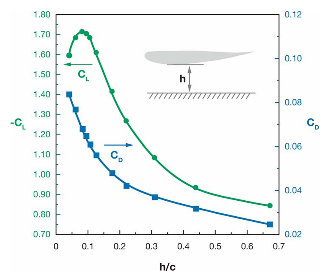
Figure 4. Downforce and drag coefficient versus ground clearance for an inverted LS(1)-0413 airfoil.[9]
This graph makes the trend and the effect's considerable magnitude quite evident, especially when the ground clearance is less than the quarter chord of the airfoil. The design of the floor and channel can use the Bernoulli principle to form a high-speed airflow under the car, to produce a ground-absorbing effect.
\( {P_{1}}+\frac{1}{2}ρV_{1}^{2}+ρg{h_{1}}=C \) (5)
When the height between the chassis and the ground decreases, which means the space between them reduces, the velocity of airflow passing through the slide increases rapidly and leads to a low-pressure area. There will be a downward force due to the increased pressure above the car because of the shortened distance between the chassis and the ground, some of the air that would normally go beneath is forced to go over the roof.
4. Components of Race Cars
To produce a desired level of downforce negative lift for the least amount of drag is the main goal of race vehicle aerodynamics. On the other hand, the downforce balance at all acceleration and speed levels is equally crucial. As such, the complex flow features associated with individual components are often interwoven and difficult to separate. Nevertheless, a clear understanding of flow physics connected to individual aerodynamic components is a prerequisite for gaining an insight into the overall flow field and eventually a better vehicle design [10]. This section will talk about the effects of the front spoiler, rear spoiler (tail) and vortex generators on the force analysis of the car.
4.1. Front Spoiler
A professional racing car will have many spoilers, such as the front spoiler and the rear spoiler. They can offset part of the aerodynamic lift and control the car to float, so that the car can be driven closely to the road, to improve the stability of the car.
Lift coefficient and lift:
\( {C_{L}}≡\frac{{F_{L}}}{(\frac{1}{2})ρ{U^{2}}A} \) (6)
\( {F_{L}}=-ρUk \) (7)
, where \( {F_{L}} \) is the lift, \( ρ \) is the air density, \( U \) is the upthrust and \( A=bc \) by looking at Fig. 5
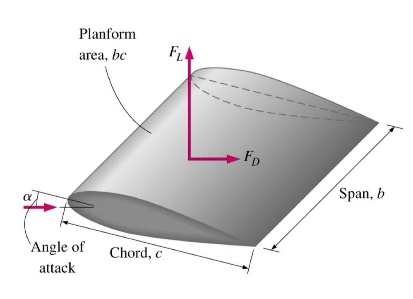
Figure 5. The lateral view of the shape of wings
According to potential flow theory, the pressure coefficient is:
\( {C_{P}}=\frac{p-{p_{∞}}}{\frac{1}{2}ρ{U^{2}}}=1-\frac{1}{{U^{2}}}{(\frac{k}{2πa}-2Usinθ)^{2}} \) (8)
generates a lift coefficient:
\( {C_{L}}=-\frac{1}{2}\int _{0}^{2π}{C_{P}}dθ=-\frac{k}{Ua} \) (9)
At the same time, the lift will induce some drag, called Lift Induced Drag:
\( {C_{Di}}=\frac{C_{L}^{2}}{π}×\frac{c}{b} \) (10)
where c is chord length and b is span of wing
\( {F_{Di}}=\frac{{L^{2}}}{\frac{1}{2}{ρ_{0}}V_{E}^{2}π{b^{2}}} \) (11)
According to Joukowski Transformation, for small angles, there is a significant relationship between lift coefficient and angle of attack:
\( {C_{L}}=\frac{{F_{L}}}{(\frac{1}{2})ρ{U^{2}}(4a)}=2πsinαcosβ≈2πα \) (12)
The effect of changing the flap angle ( \( {-10^{°}}, {-5^{°}}, {0^{°}}, {5^{°}} \) and \( {10^{°}} \) ) of the rear wing on the downforce and drag was studied by using the CFD analysis. It was shown by increasing flap angles the downforce and drag were increased It was concluded that the best performance for both wings has achieved at \( {5^{°}} \) angle of attack [11]. The disturbance of the airflow increases the downward force, which helps the vehicle to still adhere to the road at high speeds and improves tire grip, thus improving stability and handling.
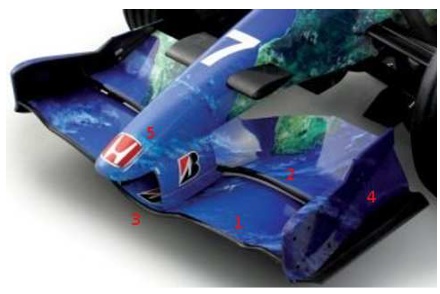
Figure 6. Configuration of the modern front wing. Two-element airfoil (1 & 2) is mounted under the nose of the car (5). Endplates (4) direct air around the wheels and curved area (4) under the nose increases the wing’s efficiency [12]
About 1/3 of the car's downforce is produced by the front wing, which has undergone more alterations than the rear wing. Since it comes into contact with the air mass initially, its primary function is to efficiently direct airflow towards the car's body and rear, as the turbulent flow can negatively affect the efficiency of the rear wing. This is in addition to producing downforce. Therefore, the vehicle equipped with the aerodynamic package can significantly improve the performance of the whole vehicle [13].
4.2. Rear Spoiler (Tail)
The tail wing is an important aerodynamic component of the racing car, which can create a turbulence area and improve the stability of the vehicle. A viable method of increasing the car's stability is to put the tail in the back. Therefore, by installing a tail wing at the rear of the vehicle, it can provide greater downward pressure for the high-speed vehicle and increase the adhesion between the vehicle and the ground. So that the vehicle can achieve the better dynamic performance, and improve the aerodynamic performance and handling stability of the vehicle [14].
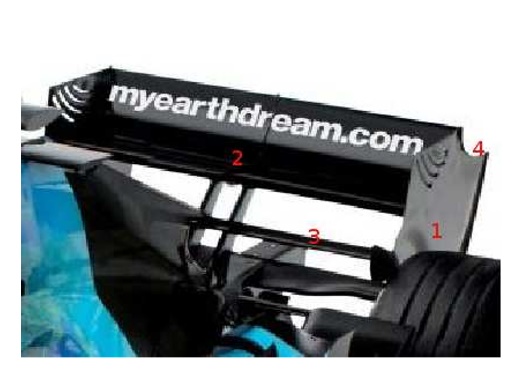
Figure 7. Modern rear wing consists of upper(2) and lower(3) airfoil sections mounted on endplates (1) with U-shaped cutouts (4).
The rear spoiler can increase the surface pressure of the car body, increase the adhesion between the tyres and the ground, change the flow field at the rear of the car, and reduce the lift caused by the airflow whirling at the rear so that when the car is driving at high speeds, the phenomenon of "floating" due to the weak adhesion at the rear will not occur [15]. At the same time, it can also direct the airflow, reducing the roll of the vehicle. A study was conducted by G. Saxena and V. Shukla [16]. Table 1 displays comparison data between the standard car and the vehicle with spoilers.
Table 1. Drag and lift coefficients of passenger cars with or without fins
Configuration | Drag coefficient | Reduction from base model (%) | Lift coefficient | Reduction from base model (%) |
Base model | 0.60 | 0 | 0.25 | 0 |
Splines and rare spoiler | 0.51 | 15% | 0.22 | 12% |
4.3. Vortex Generators
A vortex generator is a small aerodynamic device that is installed on the surface of vehicles, such as cars, aeroplanes, and trains, to manipulate the airflow and improve aerodynamic performance. It consists of small fins or vanes that are strategically placed to create vortices or swirling patterns in the air. These vortices help to control the boundary layer airflow, reducing drag, and improving the overall stability and performance of the vehicle, as Fig. 7 illustrates the typical incorporation of such VGs into the vehicle underbody. The goal of such an application is to create a strong and stable vortex that, as said earlier, can generate suction loads along its trail. The VG is significantly taller than the local boundary-layer thickness.
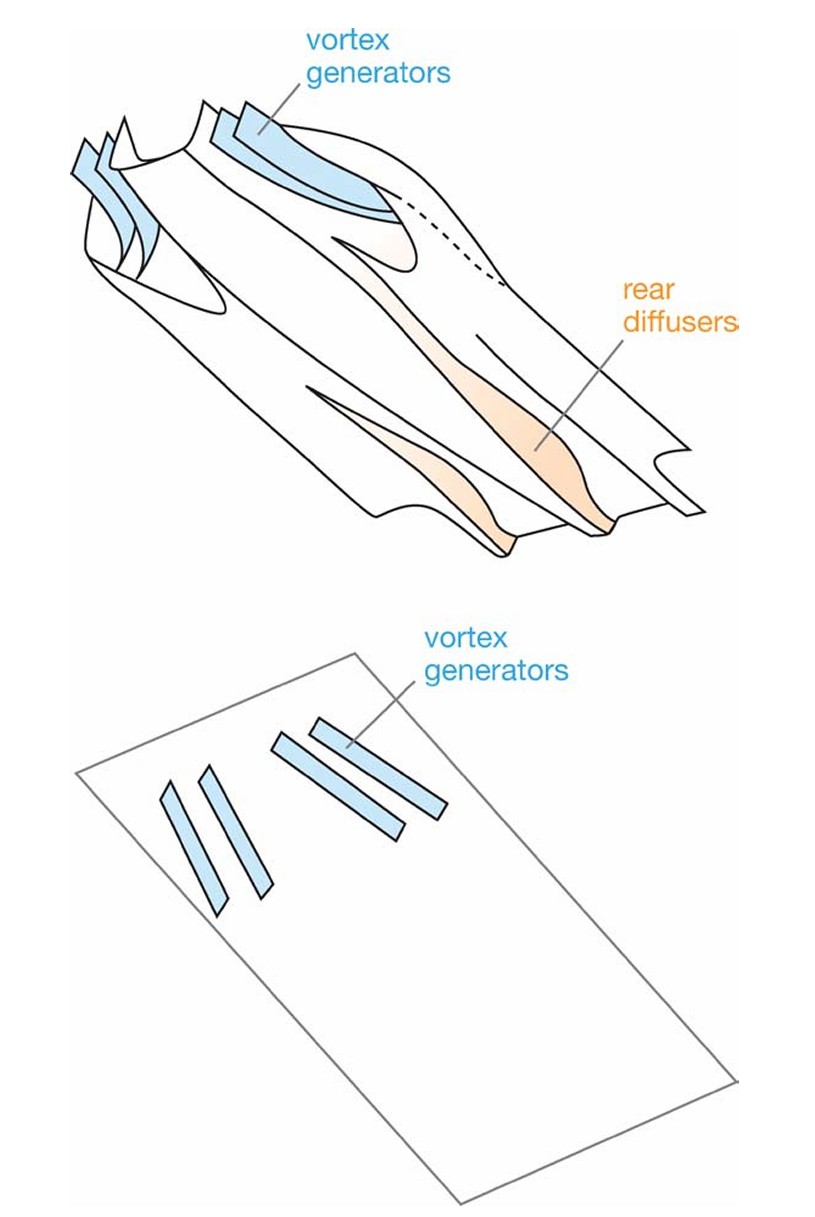
Figure 8. Schematic description of a circa year 2000 Indy car underbody and a simple flat-plate model with vortex generators (VGs). Note the two per-side VGs at the front.
Apart from that, it can also be installed on the roof of the car, as Fig.8 shows below:
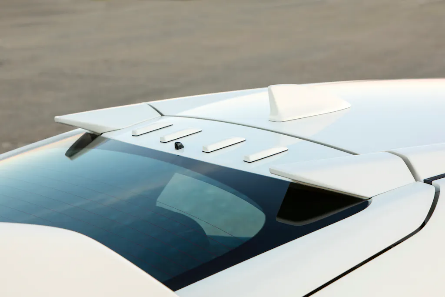
Figure 9. A car roof with vortex generators.
It was found that the optimum height of the VGs is almost equivalent to the thickness of the boundary layer (15 to 25 mm) and the optimum method of placement is to arrange them in a row in the lateral direction 100 mm upstream of the roof end at intervals of 100 mm [17]. The main function of the vortex generator is to effectively make some small turbulent flow to prevent the separation of the various air streams and loss of speed.
5. Conclusion
This essay concludes with a detailed explanation of how different automotive parts impact the vehicle's force analysis. Significant sources of downward force include the ground effect, front, rear, and vehicle shapes. In addition to creating an area of turbulence, vortex generators can help control the airflow in the boundary layer. They are all essential parts for keeping race cars stable. Nevertheless, this article still has several deficiencies. For instance, there are additional parameters, such as vehicle width, chassis area, wind turner, wing/vehicle interactions, tiny aspect ratio wings, and so forth, that impact the force's amplitude and direction. In the future, by current scientific studies, computational fluid dynamics (CFD) simulations are used to analyze and optimize the vehicle's exterior design to reduce turbulence and increase downforce, and mobile aerodynamic elements (such as adjustable rear wings) are developed to adapt to different speeds and track conditions from an aerodynamic point of view. Meanwhile, design a lightweight, highly rigid chassis to improve handling performance and stability and optimize the suspension geometry and configuration of components such as springs and shock absorbers to improve the car's grip on the chassis and suspension system. In the distribution of weight, study how to distribute the weight of the vehicle and the best height of the center of gravity to improve stability and reduce roll. In terms of tire technology, high-performance tires are studied to improve grip and optimize the tire's contact area and pressure distribution. Eventually, designing an efficient cooling system is essential for the racing car's heat dissipation, especially when it is traveling at a high speed and increased heat dissipation needs are met. research on cutting-edge brake technologies, like carbon ceramic brake discs, that can disperse heat more quickly and consistently.
References
[1]. Aerodynamics of road vehicles: from fluid mechanics to vehicle engineering[M]. Elsevier, 2013.
[2]. KA D K. Hydrogen Internal Combustion Engine Vehicles [J]. Journal of Advancement in Machines (e-ISSN: 2582-2233), 2022, 7(1): 26-32.
[3]. Katz J. Race car aerodynamics[J]. Robert Bentley, 1995. pp.2-46
[4]. Hucho W, Sovran G. Aerodynamics of road vehicles[J]. Annual review of fluid mechanics, 1993, 25(1): 485-537.
[5]. Anderson, J. Fundamentals of aerodynamics [M]. McGraw-Hill Higher Education, 2016, pp.63
[6]. Kundu P K, Cohen I M, Dowling D R. Fluid mechanics[M]. Academic press, 2015. pp.774
[7]. Wright P. Formula 1 Technology, Society of Automotive Engineers[J]. Inc., Warrendale, USA, 2001.
[8]. Bearman P W. Bluff body flows applicable to vehicle aerodynamics[J]. 1980.
[9]. Katz J. Aerodynamics of race cars[J]. Annu. Rev. Fluid Mech., 2006, 38: 27-63.
[10]. Zhang X, Toet W, Zerihan J. Ground effect aerodynamics of race cars[J]. 2006.
[11]. Fareeq S. Aerodynamic evaluation of racing wings of a formula car[J]. University of Herdfordshire, United Kingdom, 2015.
[12]. Seljak G. Race car aerodynamics[J]. University of Ljubljana Faculty of mathematics and physics, Department of physics, 2008.
[13]. Ni Jun, Wu Zhi Cheng, CHEN Si Zhong. Virtual experiment on the influence of tail angle of attack on the performance of formula car [J]. Mechanical design and research, 2012, 28 (02): 96-99.
[14]. Yu W, Gao W. A Review of the influence of active aerodynamic tail on vehicle handling stability[C]//Journal of Physics: Conference Series. IOP Publishing, 2021, 1985(1): 012017.
[15]. Li Guoqiang, Zhao Hanqing. Analysis of high speed steering drift of tracked vehicle [J]. Engineering machinery, 2019, 50 (09): 38-42 + 7.
[16]. Shukla V, Saxena G. Computational Drag Analysis of Passenger Car Using Splines and Spoiler [J]. International Journal of Engineering Trends and Technology, 2015, 21(1):1-11.
[17]. Koike M, Nagayoshi T, Hamamoto N. Research on aerodynamic drag reduction by vortex generators[J]. Mitsubishi motors technical review, 2004, 16: 11-16.
Cite this article
Xia,Y. (2024). The way to maintain the stability of race cars at high speed. Applied and Computational Engineering,66,87-95.
Data availability
The datasets used and/or analyzed during the current study will be available from the authors upon reasonable request.
Disclaimer/Publisher's Note
The statements, opinions and data contained in all publications are solely those of the individual author(s) and contributor(s) and not of EWA Publishing and/or the editor(s). EWA Publishing and/or the editor(s) disclaim responsibility for any injury to people or property resulting from any ideas, methods, instructions or products referred to in the content.
About volume
Volume title: Proceedings of the 2nd International Conference on Functional Materials and Civil Engineering
© 2024 by the author(s). Licensee EWA Publishing, Oxford, UK. This article is an open access article distributed under the terms and
conditions of the Creative Commons Attribution (CC BY) license. Authors who
publish this series agree to the following terms:
1. Authors retain copyright and grant the series right of first publication with the work simultaneously licensed under a Creative Commons
Attribution License that allows others to share the work with an acknowledgment of the work's authorship and initial publication in this
series.
2. Authors are able to enter into separate, additional contractual arrangements for the non-exclusive distribution of the series's published
version of the work (e.g., post it to an institutional repository or publish it in a book), with an acknowledgment of its initial
publication in this series.
3. Authors are permitted and encouraged to post their work online (e.g., in institutional repositories or on their website) prior to and
during the submission process, as it can lead to productive exchanges, as well as earlier and greater citation of published work (See
Open access policy for details).
References
[1]. Aerodynamics of road vehicles: from fluid mechanics to vehicle engineering[M]. Elsevier, 2013.
[2]. KA D K. Hydrogen Internal Combustion Engine Vehicles [J]. Journal of Advancement in Machines (e-ISSN: 2582-2233), 2022, 7(1): 26-32.
[3]. Katz J. Race car aerodynamics[J]. Robert Bentley, 1995. pp.2-46
[4]. Hucho W, Sovran G. Aerodynamics of road vehicles[J]. Annual review of fluid mechanics, 1993, 25(1): 485-537.
[5]. Anderson, J. Fundamentals of aerodynamics [M]. McGraw-Hill Higher Education, 2016, pp.63
[6]. Kundu P K, Cohen I M, Dowling D R. Fluid mechanics[M]. Academic press, 2015. pp.774
[7]. Wright P. Formula 1 Technology, Society of Automotive Engineers[J]. Inc., Warrendale, USA, 2001.
[8]. Bearman P W. Bluff body flows applicable to vehicle aerodynamics[J]. 1980.
[9]. Katz J. Aerodynamics of race cars[J]. Annu. Rev. Fluid Mech., 2006, 38: 27-63.
[10]. Zhang X, Toet W, Zerihan J. Ground effect aerodynamics of race cars[J]. 2006.
[11]. Fareeq S. Aerodynamic evaluation of racing wings of a formula car[J]. University of Herdfordshire, United Kingdom, 2015.
[12]. Seljak G. Race car aerodynamics[J]. University of Ljubljana Faculty of mathematics and physics, Department of physics, 2008.
[13]. Ni Jun, Wu Zhi Cheng, CHEN Si Zhong. Virtual experiment on the influence of tail angle of attack on the performance of formula car [J]. Mechanical design and research, 2012, 28 (02): 96-99.
[14]. Yu W, Gao W. A Review of the influence of active aerodynamic tail on vehicle handling stability[C]//Journal of Physics: Conference Series. IOP Publishing, 2021, 1985(1): 012017.
[15]. Li Guoqiang, Zhao Hanqing. Analysis of high speed steering drift of tracked vehicle [J]. Engineering machinery, 2019, 50 (09): 38-42 + 7.
[16]. Shukla V, Saxena G. Computational Drag Analysis of Passenger Car Using Splines and Spoiler [J]. International Journal of Engineering Trends and Technology, 2015, 21(1):1-11.
[17]. Koike M, Nagayoshi T, Hamamoto N. Research on aerodynamic drag reduction by vortex generators[J]. Mitsubishi motors technical review, 2004, 16: 11-16.





